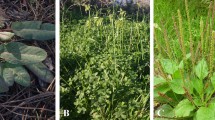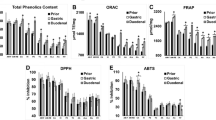Abstract
Spectrophotometric and chromatographic analysis of phenolics in water and ethanolic extracts of wild asparagus, butcher’s broom and black bryony from Croatia was conducted. Their antioxidant capacity (ABTS, DPPH and FRAP assay) and energy content were determined. The gastrointestinal stability of detected phenolics was determined using a two-phase in vitro digestion method with human enzymes. The highest phenolics yield, radical scavenging activity and ferric reducing antioxidant potential were recorded in 40 % ethanolic extract of black bryony, with glycosylated forms of kaempferol as dominant components. Quercetin-3-O-rutinoside and isorhamnetin-3-O-rutinoside were dominant phenolics in all wild asparagus extracts, and salicylic acid was predominant in butcher’s broom 40 % ethanolic extract. Phenolic acids of the three species were not stable during gastric and duodenal phases of simulated digestion. Two main black bryony kaempferol glycosides were best preserved after digestion (50 % of each). Black bryony contains more energy than wild asparagus and butcher’s broom. Accordingly, we propose black bryony as a valuable source of antioxidant kaempferol glycosides with relevant gastrointestinal stability and higher energy content than so far more conventional vegetable wild asparagus.



Similar content being viewed by others
References
Tutin TG, Burges NA, Chater AO (1964–1993) Flora europaea. Cambridge University Press, Cambridge
Uttara B, Singh AV, Zamboni P, Mahajan RT (2009) Oxidative stress and neurodegenerative diseases: a review of upstream and downstream antioxidant therapeutic options. Curr Neuropharmacol 7:65–74
Fearon IM, Faux SP (2009) Oxidative stress and cardiovascular disease: novel tools give (free) radical insight. J Mol Cell Cardiol 47:372–381
Sosa V, Moliné T, Somoza R, Paciucci R, Kondoh H, LLeonart ME (2013) Oxidative stress and cancer: an overview. Ageing Res Rev 12:376–390
Salvatore S, Pellegrini N, Brenna OV, Del Rio D, Frasca G, Brighenti F, Tumino R (2005) Antioxidant characterization of some Sicilian edible wild greens. J Agric Food Chem 53:9465–9471
Barros L, Dueñas M, Ferreira ICFR, Carvalho AM, Santos-Buelga C (2011) Use of HPLC-DAD-ESI/MS to profile phenolic compounds in edible wild greens from Portugal. Food Chem 127:169–173
Ferrara L, Dosi R, Di Maro A, Guida V, Cafarelli G, Pacifico S, Mastellone C, Fiorentino A, Rosati A, Parente A (2011) Nutritional values, metabolic profile and radical scavenging capacities of wild asparagus (A. acutifolius L.). J Food Compos Anal 24:326–333
Di Maro A, Pacifico S, Fiorentino A, Galasso S, Gallicchio M, Guida V, Severino V, Monaco P, Parente A (2013) Raviscanina wild asparagus (Asparagus acutifolius L.): a nutritionally valuable crop with antioxidant and antiproliferative properties. Food Res Int 53:180–188
Skotti E, Anastasaki E, Kanellou G, Polissou M, Tarantilis PA (2014) Total phenolic content, antioxidant activity and toxicity of aqueous extracts from selected Greek medicinal and aromatic plants. Ind Crop Prod 53:46–54
Negi JS, Singh P, Joshi GP, Rawat MS, Bisht VK (2010) Chemical constituents of Asparagus. Pharmacogn Rev 4:215–220
Benítez G, González-Tejero MR, Molero Mesa J (2010) Pharmaceutical ethnobotany in the western part of Granada province (southern Spain): ethnopharmacological synthesis. J Ethnopharmacol 129:87–105
Shaheen F, Ali L, Erdemoglu N, Sener B (2009) Antioxidant flavonoids from Tamus communis ssp. cretica. Chem Nat Compd 45:346–349
Barreira JCM, Pereira E, Dueñas M, Carvalho AM, Santos C, Santos-Buelga C, Ferreira ICFR (2013) Bryonia dioica, Tamus communis and Lonicera periclymenum fruits: characterization in phenolic compounds and incorporation of their extracts in hydrogel formulations for topical application. Ind Crop Prod 49:169–176
Kovács A (2009) Isolation and structure elucidation of compounds with antitumor activity from Tamus communis and Xanthium italicum. Ph.D. Thesis. Department of Pharmacognosy, University of Szeged, Hungary
Lovati M, Pace R (2002) Identification of Ruscus steroidal saponins by HPLC-MS analysis. Fitoterapia 73:583–596
Vertuani S, Bosco E, Testoni M, Ascanelli S, Azzena G, Manfredini S (2004) Antioxidant herbal supplement for hemorrhoids: developing a new formula. Nutrafoods 3:19–26
García-Herrera P, Cortez Sánchez-Mata M, Cámara M, Tardío J, Olmedilla-Alonso B (2013) Carotenoid content of edible young shoots traditionally consumed in Spain (Asparagus acutifolius L., Humulus lupulus L., Bryonia dioica Jacq. and Tamus communis L.). J Sci Food Agric 93:1692–1698
Raphael M, Barros L, Carvalho AM, Ferreira ICFR (2011) Topical anti-inflammatory species: bioactivity of Bryonia dioica, Tamus communis and Lonicera periclymenum fruits. Ind Crop Prod 34:1447–1454
Martins D, Barros L, Carvalho AM, Ferreira ICFR (2011) Nutritional and in vitro antioxidant properties of edible wild greens in Iberian Peninsula traditional diet. Food Chem 125:488–494
Cheynier V, Comte G, Davies KM, Lattanzio V, Martens S (2013) Plant phenolics: recent advances on their biosynthesis, genetics, and ecophysiology. Plant Physiol Biochem 72:1–20
Singleton VL, Rossi JA (1965) Colorimetry of total phenolics with phosphotungstic acid reagents. American J Enol Vitic 16:144–158
Ough CS, Amerine MA (1988) Methods for analysis of musts and wine. Wiley, New York
Fuentes-Alventosa JM, Rodríguez G, Cermeño P, Jiménez A, Guillén R, Fernández-Bolanos J, Rodríguez-Arcos R (2007) Identification of flavonoid diglycosides in several genotypes of Asparagus from the Huétor-Tájar population variety. J Agric Food Chem 55:10028–10035
Brand-Williams W, Cuvelier ME, Berset C (1995) Use of free radical method to evaluate antioxidant activity. Lebensm Wiss Technol 28:25–30
Blois MS (1958) Antioxidant determinations by the use of a stable free radical. Nature 181:1199–1200
Re R, Pellegrini N, Proteggente A, Pannala A, Yang M, Rice-Evans C (1999) Antioxidant activity applying an improved ABTS radical cation decolorization assay. Free Radic Biol Med 26:1231–1237
Benzie IF, Strain JJ (1996) The ferric reducing ability of plasma (FRAP) as a measure of “antioxidant power”: the FRAP assay. Anal Biochem 239:70–76
Almaas H, Holm H, Langsrud T, Flengsrud R, Vegarud GE (2006) In vitro studies of the digestion of caprine whey proteins by human gastric and duodenal juice and the effects on selected microorganisms. Br J Nutr 96:562–569
Furlund CB, Kristoffersen AB, Devold TG, Vegarud TE, Jonassen CM (2012) Bovine lactoferrin digested with human gastrointestinal enzymes inhibits replication of human echovirus 5 in cell culture. Nutr Res 32:503–513
López-Mejía OA, López-Malo A, Palou E (2014) Antioxidant capacity of extracts from amaranth (Amaranthus hypochondriacus L.) seeds or leaves. Ind Crop Prod 53:55–59
Morales P, Carvalho AM, Sánchez-Mata MC, Cámara M, Molina M, Ferreira ICFR (2012) Tocopherol composition and antioxidant activity of Spanish wild vegetables. Genet Resour Crop Evol 59:851–863
Boumerfeg S, Baghiani A, Messaoudini D, Khennouf S, Arrar L (2009) Antioxidant properties and xanthine oxidase inhibitory effects of Tamus communis L. root extracts. Phytother Res 23:283–288
Fuentes-Alventosa JM, Jaramillo S, Rodríguez-Gutiérrez G, Cermeño P, Espejo JA, Jiménez-Araujo A, Guillén-Bejarano R, Fernández-Bolaños J, Rodríguez-Arcos R (2008) Flavonoid profile of green asparagus genotypes. J Agric Food Chem 56:6977–6984
Luís A, Domingues F, Duarte AP (2011) Bioactive compounds, RP-HPLC analysis of phenolics, and antioxidant activity of some Portuguese shrub species extracts. Nat Prod Commun 6:1863–1872
Lazarova I, Zengin G, Aktumsek A, Gevrenova R, Ceylan R, Uysal S (2014) HPLC-DAD analysis of phenolic compounds and antioxidant properties of Asphodeline lutea roots from Bulgaria and Turkey. Ind Crop Prod 61:438–441
Hadžifejzović N, Kukić-Marković J, Petrović S, Soković M, Glamočlija J, Stojković D, Nahrstedt A (2013) Bioactivity of the extracts and compounds of Ruscus aculeatus L. and Ruscus hypoglossum L. Ind Crop Prod 49:407–411
Thaipong K, Boonprakob U, Crosby K, Cisneros-Zevallos L, Hawkins Byrne D (2006) Comparison of ABTS, DPPH, FRAP, and ORAC assays for estimating antioxidant activity from guava fruit extracts. J Food Compos Anal 19:669–675
Liu C, Zhao Y, Li X, Jia J, Chen Y, Hua Z (2014) Antioxidant capacities and main reducing substance contents in 110 fruits and vegetables eaten in China. Food Nutr Sci 5:293–307
Tiveron AP, Melo PS, Bergamaschi KB, Vieira TMFS, Regitano-d’Arce MAB, Alencar SM (2012) Antioxidant activity of Brazilian vegetables and its relation with phenolic composition. Int J Mol Sci 13:8943–8957
Siracusa L, Kulišić-Bilušić T, Politeo O, Krause I, Dejanović B, Ruberto G (2011) Phenolic composition and antioxidant activity of aqueous infusions from Capparis spinosa L. and Crithmum maritimum L. before and after submission to a two-step in vitro digestion model. J Agric Food Chem 59:12453–12459
Tarko T, Duda-Chodak A, Zajac N (2013) Digestion and absorption of phenolic compounds assessed by in vitro simulation methods. A review. Rocz Państw Zakł Hig 64:79–84
Acknowledgments
The authors thank Dr. Marko Miliša (Faculty of Science, Zagreb) for technical assistance with calorimeter bomb and Dr. Viljemka Bučević-Popović (Faculty of Science, University of Split) for help in determination of human digestive juices’ enzymatic activity. This research was not financially supported.
Author information
Authors and Affiliations
Corresponding author
Ethics declarations
Conflict of interest
The authors declare that they have no conflict of interest.
Ethical standard
This article contains a study with human digestive juices. The approval for the collection of digestive juices was obtained from the Ethics Committee of the University Hospital Centre Split (11/09/2014).
Additional information
Danijela Poljuha and Ivana Šola have contributed equally to this work.
Electronic supplementary material
Below is the link to the electronic supplementary material.
Rights and permissions
About this article
Cite this article
Poljuha, D., Šola, I., Bilić, J. et al. Phenolic composition, antioxidant capacity, energy content and gastrointestinal stability of Croatian wild edible plants. Eur Food Res Technol 241, 573–585 (2015). https://doi.org/10.1007/s00217-015-2486-y
Received:
Revised:
Accepted:
Published:
Issue Date:
DOI: https://doi.org/10.1007/s00217-015-2486-y




